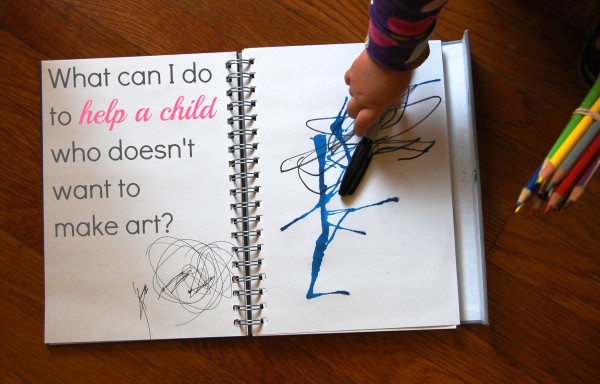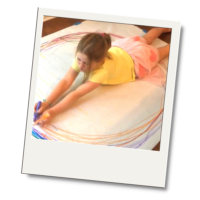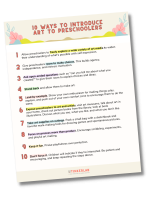If you have a child or if you work with children, chances are that you’ve experienced at least one instance of an art project or invitation being met with refusal. Can you think of a time?
When my older daughter was about 2.5 she wouldn’t touch crayons, markers, or any sort of mark-making tool. She didn’t start out this way, and I scratched my head trying to find a way to make drawing more fun.
I introduced drawing games such as playing with art dice, which made drawing more adventurous. I looked for novel ways to draw with unusual materials such as drawing on windows with dry erase markers, and we were back into the swing of things.
I also tried to step back and pay attention to her interests.
What did she enjoy doing? When she played on her own, what did she gravitate toward? When I did this, I noticed that she enjoyed the challenges of building activities: building block towers, stacking pillows on the furniture, and making structures out of toys. So I switched up our routine and offered her sculptural prompts such as building recycled sculptures.
We’re not all wired with an artsy gene, and I know plenty of children and adults who never find their way to the art table, but just because a child doesn’t show an interest in art do not make the assumption that it will always be that way. My daughter is a case-in-point!
Are you struggling with this problem or have you been there/done that?
Every child is unique, and we all approach challenges like this from different perspectives. I would love to hear how you have helped a child who wasn’t interested in making art. Do you have a strategy that worked? All tips are welcome — my hope is that this post will be a valuable resource for parents and teachers who may inevitably find themselves in this same situation.





I’ve been in the middle of this dilema for a while now. My little guy is plenty creative, but would generally refuse to do any coloring, drawing, etc. Partly, we’ve added a lot more exploration and process style art, and partly I’ve started doing it with him. When he sees me flailing along beside him, he’s more willing to try.
Part of what makes it hard for him is that his skills don’t live up to his dreams yet. (A problem I can relate to which just makes it harder!) He has a clear idea of what he wants a finished project to look like, and when it doesn’t he gets upset. While I praise his work either way, it only helps a little bit.
Hi Cady! This is a great reminder of how creating alongside children can elevate enthusiasm for a project. My preschooler will often ask me to make art alongside her, and I’ve noticed that when I get a “good idea,” try something new, or make mistakes, it peaks her own curiosity.
As an art teacher and mom of 4, I know that sometimes what I think will be great fun is met with less than enthusiasm from my students and children. In my classroom I have found that the best relief to this dilema is choice. Choice can come in choice of material, subject, or solution to problem. As a parent, I never try to force the creativity and have materials available for when the mood strikes. In both settings I find that leaving some new materials lying around for “discovery” is usually a great tactic.
I’m glad you raised the point that grown-up ideas and kid-ideas can be so very different, Mikel! Just because we think that a project is worth doing does not mean that a child will feel the same way. Your suggestion to make “materials available” works for me too, and sometimes in the most surprising ways. In recent examples, my preschooler gathered pen and paper to make signs to decorate our make believe grocery store, and my toddler recently organized a group of seashells and covered each one with a sticker. It’s so important to set up an area for self-serve suplies!
My boys don’t like to be told what to do…I usually make them think they have thought of it. Having said that, they didn’t seem to mind the lawn being covered in paper and paint put out in trays across the middle. I chased them back and forth and once they realized what was happening they got very into the footprints and ended up rolling, using hands, grabbing sticks…you name it…. 🙂
Hi Sarah! I love how you connected to your boys’ strengths and interests, and turned this into a game. Art isn’t a chore and should be fun!
Hello, I created 3 collaborative/cooperative games that encourage creative and imaginative thinking AND involve art making. One of the games, PaintPlay is for children 6+ and allows kids make art while they play so if your child is tentative about approaching art as a stand along activity, they might like playing a game that involves art making but in a fun and new way.
Wow, Gina, that’s really cool. I agree that making a game out of drawing or painting can be a successful approach.
Gina — we just got PaintPlay in stock in our store this week. I haven’t had a chance to open one yet, but it does look really cool. Sort of a mix of some of the story- or activity-prompt games we have been seeing a lot of lately and a collaborative art-making experience? Neat.
as an art therapist, i actually do believe that we’re all wired with an artsy gene. as ellen dissanayake says, “art is a universal and a biological trait of the human species.” and that “making special” is one of our innate drives. (https://en.wikipedia.org/wiki/Ellen_Dissanayake)
when i encounter resistance to making art in my child or in a client, i drop my own agenda and try to be with and accept what IS. much like you said in your post, rachelle, i also broaden my own thinking about what “art” entails, and look at what they ARE creating in the world (building, dancing, etc.) and support THAT.
if you are trying to encourage a child to participate in traditional visual arts, some non-threatening ways i like to start are:
1) the scribble drawing (https://www.paintcutpaste.com/scribble-drawing/)
2) to encourage the child (or my client) to choose any material (texture & color, from many presented to them) and to just “make a mark” on a page. (the children’s book “the dot” reminds me of this approach, and it’s a really sweet read.)
3) sometimes going back to the sensory experience of the art materials is enough to entice a child — give them a chunk of clay or dough to “just play with” or offer a bowl of stones, a sensory tub, a tray of shaving cream, or other pre-art materials.
4) i also like to talk with them about images/imagery… like having them close their eyes and walk them through a visualization, and talk about what they see. or to talk about the images of a dream. or to intimately observe an object in nature and describe what they see. this often really inspires one to make art.
5) also i’ve found that sometimes making my own art (in the presence of the child or showing them a piece after it’s created) can help to work with some of my own feelings that come up around meeting resistance and has worked to inspire the child to then make their own art. when making art in the service of a child or client in this way, i often make my art in their “handwriting” (so to speak) instead of my own. i write about this here: https://www.paintcutpaste.com/empathy-art and here: https://www.kiwico.com/blog/1445/lets-talk-about-art/
these are just a few of my initial thoughts on this topic — thanks for posting this and asking this important question, rachelle!
Oh Jen, I’m so glad you took time (away from your vacation, maybe?) to share your thoughts. Thanks for including the ellen dissanayake link. I agree that we all have the potential to be creative, and I suppose I was being a bit flip by saying that we’re not all wired with an “artsy gene.” My point, really, is that some of us just don’t gravitate toward or make time for the visual arts, in the same way that some people don’t gravitate toward exercise. Most of us are built to walk, but how many of us run or go to the gym every day? Phew, glad I said that — I hate it when I’m not clear in my writing.
Thank you for your thoughtful ideas, suggestions, and links — you’re a treasure.
i totally get what you mean by the artsy gene, of course. (especially with your brilliant analogy to walking/running – i only run when chased, and even then i’m more apt to hang a sharp right and hide in an alleyway just to avoid running, but anyway….) your writing is definitely clear and wonderful. i love that you posed this question (and so many other wonderful ones!!!) on your blog. ps – i’m back on the west side now, enjoying the lack of humidity. whew!
Another reader commented her boys hate to be told what to do. Mine are exactly like that. I usually “strew” books, activities and art stuff around for them to “find.” I try to change it up regularly so it’s not just a plain ol’ mess, but that doesn’t always happen. I haven’t actually done this, but for some reason it just occurred to me I should put all the art supplies in a large clear bin and lock it. I’m pretty sure that would miraculously turn them into (whining!) would-be Picassos. As with so many kids, the most interesting stuff is that which they can’t have. Thanks for the thought-provoking site!
Christine, your idea is so outside the box that it just might work 🙂 My kids love getting mail and then want to open and use whatever has arrived right away. Maybe you could wrap the materials in a cardboard box and pretend they were just delivered. I’d love to hear how this works if you try it.
After clicking over to your website, I had to circle back and say HOLY-COW, you’re encaustic paintings are gorgeous! I’m a fan. I couldn’t find any info about YOU there, though. Am I missing something?
My son (7) has autism and doesn’t really enjoy craft projects. I still want him to flex his creative muscles in a way that doesn’t come naturally to him. I offer him a reward to do a good job and be involved. Then he is doing it because he wants to (for a reward) and I don’t have to harp on him to attempt a project. Sometimes I remind him of our “deal” to keep him on track. He gets to try something new that he may enjoy and I get to push his boundaries out a bit for him without any struggle. Sometimes he will participate without any reward and I call that a win!
I would call that a win, too! Thanks for sharing your story, Monique 🙂
Start by watching him as he goes about his day. What DOES he wanna do, what does he keep going back to “work” on or do again? Would he rather spend half and hour playing with legos than finger painting?Roughhousing over reading?Does he pretend to be a ninja ? XD Creativity can be channeled throuh many number of things.Don’t let anything define what creativity may mean for him.And don’t compare yourself to any other mom on Pinterest .Just be you , and laugh a lot with the little guy 😉
I love that you have thrown this question out there. Thank you! I sometimes struggle to find ways to engage my son’s artistic side. He loves play dough (especially if he is driving cars and trucks through it), but has never been one to enjoy drawing or coloring for very long. We do it together, which is always fun, but one of the most successful ways I’ve found to engage him is to take our art outside. Painting rocks is one of his favorite artsy activities 🙂 He also seemed to get more comfortable with drawing after we read “Ish” and “The Dot” by Peter Reynolds. Both are wonderful and I highly recommend them! I wrote a little more about how “Ish” seemed to influence him here: http://365greatchildrensbooks.blogspot.com/2012/05/day-155-ish.html
Thanks again for the great topic — I look forward to checking in on what others do, too!
awesome lauren – i mention ‘the dot’ in my comment above too. we love both of those books over here, too! aren’t they great?
Hi Lauren! Taking art outside (fresh air does wonders for the mind) and eading an art book to prompt artsy play are great ideas.
My daughter (now twelve) hated coloring, and drawing and crafting. About a year ago – on her own, she started drawing and took an interest in sharpie markers and painting. I think she started because of the mention of art in her math book. They introduced the Fibonacci sequence through art. The art, abstract then ordered, exploded out of her. My son (now nine) doesn’t like coloring or crafting either but always enjoyed drawing his inventions. As with everything else, kids develop in their own way. I’ve learned that worry does little to change anything. Parents just need to love their kids and show their own appreciation of art without pressuring the kids to join in. The kids will come around in their own time.
Thank you for this beautiful reminder of a child’s ability to find her own way if we give her the room to explore.
My son is not much a big coloring guy or a big drawing guy. I noticed that he doesn’t really like to draw but he has come up with some creative scenes and then asked me to draw them. I noticed he is more of a storyteller so yesterday my son and I sat down and wrote a story together. It was a bit like mad libs but with my own questions questions. I asked, “Who should the story be about?” I asked what the character looked like, how the character felt. Then we came up with an activity for the character to do, complete with a conflict and resolution. When he was done I read the story to him and he even had some revisions for it. He was so proud and I think the part he thought was coolest was that we typed it on the computer.
I meant to say he is not a big coloring or drawing guy.
I am going to try some of these ideas. My oldest (4) is a perfectionist and expects results immediately. This means she will often not try and instead sit back because she ‘can’t do it’. I try to explain to her about practising and cheer her when her efforts result in improvement and I emphasise how she is improving her skills in little steps but it is a long process.
Does anyone have any suggestions?
Just like with reading, I think every child needs to find that book – or in this case – that art project that interests them. Once they feel that sense of accomplishment and can marvel at their creativity then they usually want to explore other areas. At least that’s been our experience.
For my youngest it was clay, my middle son was drawn to cartooning, and my eldest it was a paint project. Now they all love arts of all types.
Hey!
I’m a nanny and have been a child care provider for lots of years now. I’m not really the artist type, but I’m definitely sensory-centered. I love to get my kids to work on REALLY BIG scales and to combine art with some sort of science.
Cornstarch has taken up a permanent residence in my car (you never know when the opportunity will arise!), along with food coloring/liquid watercolors. I usually pull out all kinds of kitchen utensils- pots, pans, bowls, everything- and let them mix water and cornstarch and turn it colors. Then, the kids usually try mixing the colors and experimenting with different shades. And when we’re done, it gets poured all over the driveway on a crazy mix of color. We’ve even dribbled it with the spoons to create large murals! Have you seen “sidewalk paint”? It’s basically cornstarch and food coloring, but usually on a smaller scale. Equal parts cornstarch and water, just throw in some food coloring to your liking.
We also do baking soda and colored vinegar to make color volcanoes (do it in muffin tins to make it last a little bit longer!).
We love butcher paper in my house. So fun to create great big pictures. We love fingerprinting (or body painting), playing with jello, and we recently discovered BioColor’s foam paint. So. Fun.
Anyway, involve their whole bodies. Use different parts of their brains. And let ’em get messy- it’ll be good for you, too!
I have a very active toddler boy who loves outdoor play, so I’ve found that whenever I take art outside and let him explore the art activity, but also go play in the sandbox and come back to the art when he wants, we have the most success. bit.ly/Q3dYii
i provide window pens, small wipe clean boards and pens, small chalk boards, pavement chalk for out doors. In the summer i provde water colour palettes to paint on patio and rolls of wall paper. I also have a supply of old diaries note pads of differing sizes and shapes to write or draw in. Cars and marbles can be dipped in aint to create straight lines when rolled across paper.
Trying another medium is a great idea. My five year old wouldn’t color with crayons for anything. Just the pencil he had been using to write letters. I even wondered if he might be color blind and didn’t enjoy using crayons for that reason. Finally I decided to pull out some colored pencils (since he was coloring everything gray) to see if he would use colors that way. It worked!! His older sister then explained that the 5 year old also didn’t care for crayons because he liked to color hard and would break the crayons and get frustrated at the ruined crayon. ;(
Rhoda,
Smart you! This is an excellent suggestion. I was just talking with my daughter’s preschool teacher about crayons v. markers, and we marveled at how children really do seem to have a preference between the two. My kids rarely use crayons and always request markers when given the choice.
Rachelle